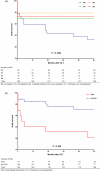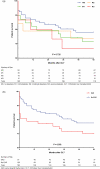Hepatic steatosis is not always a contraindication for cadaveric liver transplantation
- PMID: 21609375
- PMCID: PMC3103099
- DOI: 10.1111/j.1477-2574.2011.00310.x
Hepatic steatosis is not always a contraindication for cadaveric liver transplantation
Abstract
Background: Macrovesicular steatosis is assumed to be an important risk factor for early allograft dysfunction (EAD) after orthotopic liver transplantation (OLT).
Aim: To evaluate the impact of steatosis in combination with other risk factors on the outcome of OLT.
Methods: The degree of steatosis was analysed in 165 consecutive OLTs and was classified by histological examination as non (M0), mild (<30%, M1), moderate (30-60%, M2) or severe steatosis (>60%, M3). Recipients were analysed for EAD.
Results: EAD was observed in 28% of patients with M0, 26% with M1, 53% with M2 and 73% with M3 (P < 0.001). Patients with EAD had a significantly shorter graft survival after liver transplantation (P = 0.005) but did not correlate with survival. In multivariate regression analysis, the grade of steatosis, donating after cardiocirculatory death (DCD) grafts and duration of cold ischaemia time were significantly associated with EAD (P < 0.001, P = 0.01 and P = 0.001, respectively).
Conclusion: Livers with severe (M3) steatosis from DCD donors, combined with a prolonged CIT have a high risk for developing EAD which is correlated with shorter graft survival. Therefore M3 livers should only be considered for OLT in selected recipients without the presence of additional risk factors.
© 2011 International Hepato-Pancreato-Biliary Association.
Figures



References
-
- Koneru B, Dikdan G. Hepatic steatosis and liver transplantation current clinical and experimental perspectives. Transplantation. 2002;73:325–330. - PubMed
-
- Adam R, Reynes M, Johann M, Morino M, Astarcioglu I, Kafetzis I, et al. The outcome of steatotic grafts in liver transplantation. Transplant Proc. 1991;23:1538–1540. - PubMed
-
- Marsman WA, Wiesner RH, Rodriguez L, Batts KP, Porayko MK, Hay JE, et al. Use of fatty donor liver is associated with diminished early patient and graft survival. Transplantation. 1996;62:1246–1251. - PubMed
-
- Afonso RC, Saad WA, Parra OM, Leitao R, Ferraz-Neto BH. Impact of steatotic grafts on initial function and prognosis after liver transplantation. Transplant Proc. 2004;36:909–911. - PubMed

